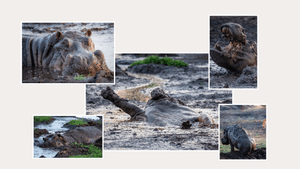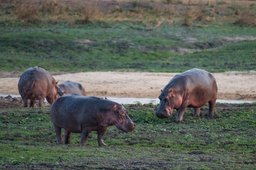You Asked the Question: Hippo Skin
By: Ethan Kinsey
I remember watching a hippo basking on a riverbank one afternoon, its massive body glistening under the relentless African sun. The midday heat was almost unbearable, even in the shade, the air felt thick and heavy. Nearby, a group of elephants coated themselves in a layer of cooling mud, while warthogs rolled happily in a shallow puddle, their bristly hairs caked with dirt. But the hippo? It just lay there, motionless, its broad back completely exposed. No fur, no mud, no visible effort to shield itself from the sun. I expected to see its skin dry out and crack under the heat, or at the very least, darken and blister as mine would without sunscreen. But it didn’t…
Unlike most large mammals, hippos have nearly no fur, a trait that helps them move easily between land and water without their skin becoming waterlogged. But this lack of fur also presents a problem, without a natural barrier, their skin is extremely sensitive to sunlight and physical damage. In fact, a hippo’s outer skin layer is surprisingly thin and fragile, so much so that it scratches and bleeds easily, even from minor abrasions. However, beneath that delicate surface lies a much thicker dermal layer, which can reach up to 6 cm (2.3 inches) in thickness in some areas. This thick skin plays an essential role in temperature regulation and protection, and it accounts for a remarkable 18% of a hippo’s total body weight.
But thick skin alone isn’t enough. The real challenge for hippos is maintaining the delicate balance between staying cool in the heat and retaining warmth in water. This is why hippos are largely nocturnal, resting in water during the hot daylight hours and becoming more active after sundown.
Some of the leading, early observers, believed these animals “sweated blood”, a dramatic but mistaken assumption. The orangey-red secretion seen was not sweat or blood but a specialised fluid produced by glands beneath the skin. One of its key components is hipposudoric acid, a red pigment that absorbs ultraviolet light, acting as a natural sunscreen. Alongside an orange pigment, these compounds provide antibacterial and anti-fungal properties, helping to prevent infections from cuts, scratches, and bites. Given the aggressive interactions common among hippos, this function is particularly important. The secretion also serves to keep the skin hydrated, counteracting the drying effects of sun and wind.
Chemically, this fluid is alkaline, with a pH ranging from 8.5 to 10.5. As it dries, it can leave behind a pinkish residue, reinforcing the myth of “blood sweat” that has persisted for centuries. Unlike humans, who rely on eccrine sweat glands for cooling, hippos have no true sweat glands. Instead, they depend on their semi-aquatic lifestyle to regulate body temperature, spending much of the day submerged to avoid overheating. When on land, their secretion helps to maintain moisture and provide additional protection.
This adaptation places hippos among the many mammals that do not rely on sweating to cool down. Most animals, including lions and other big cats, regulate their body temperature primarily through panting. The sight of a lion panting heavily even while resting is a direct result of this physiological limitation. In hippos, nature has developed a different solution, one that combines sun protection, antimicrobial defence, and skin hydration in a single biological adaptation.








